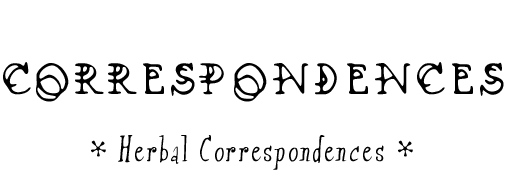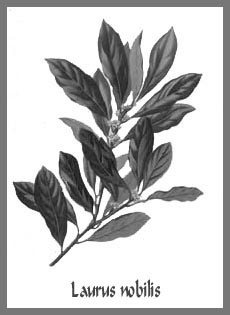 |

 NamesLaurus is derived from the Celtic, lawr, verdant, because of its evergreen nature and nobilis from Latin, high rank, due to the fact it was used to crown heroes and poets. The modern term 'bachelor' which is used for degrees is derived from the laurel berry, baccalaureus, through the French bachelier. There are many folk names for this herb some of which are Baie, Bay, Bay Laurel, Bay Tree, Daphne, Greecian Laurel, Laurel, Laurier d'Apollon, Laurier Sauce, Lorbeer, Noble Laurel, Roman Laurel, Sweet Bay, True Laurel.
CultivationThe Bay Laurel will grow in the garden in the mild climates of Zones 8-10, otherwise it is grown in a container and must remain indoors through the winter.Outdoors it must be protected from harsh winds and grown in a shaded area. Inside it does best in a cool greenhouse situation but can be grown in a home if given cooler temperatures and direct sunlight for at least four hours a day. Keep the soil moist in the spring but allow it to dry out thoroughly between waterings the rest of the year. The leaves can be used fresh or dried, and can be harvested at any time of the year.
HistoryIn Greek and Roman mythology the nymph Daphne daughter of the river god Peneus was being chased by an enamored Apollo, desperate for her love. She grew weary of the pursuit and begged her father to turn her into a laurel tree. Apollo placed his affections for Daphne to the tree and declared it sacred and that men who returned victorious would wear a crown of its leaves. The Oracles at Delphi (priestesses of Apollo) chewed bay leaves and inhaled their fumes to induce prophetic visions.The leaves are used at the pagan celebrations of Yule for their evergreen characteristic, to bring the light of summer into the darkest days of the year. It has also long been given to anyone who distinguishes him/herself of a worthy deed.
Culinary UsesBay leaf is a flavoring agent utilized extensively in French as well as many other cuisines. It has a wide variety of uses in bouillon, soups, stews, meat, fish, poultry and marinades. Always discard the leaf before serving.
Spiritual Properties and Uses in MagicBay Laurel is one of the very best protection and purification herbs. Worn as an amulet or used as a talisman it wards off negativity and evil.Placed on a window sill it protects against lightning strikes and used in the home will prevent the mischief created by poltergeists. It can be used as a smudge or burned as incense in exorcism rites. The leaf of the bay is used to sprinkle water during rituals and the leaves mixed with sandalwood can be burned to remove evil spells and curses. Placed beneath one's pillow it induces prophetic dreams, it is used in clairvoyance and wisdom teas, and the smoke can be inhaled to bring prophetic visions. If a couple takes a twig from a Laurel tree then breaks it in two, each keeping half, it will ensure that love will stay. Write a wish on a bay leaf and then burn them to make them come true. This is the herb of fame and glory, it grants strength in athletic competitions if worn as an amulet. Use laurel in any incantation and you will see the ways to put yourself on the course of immortality.
Healing Properties and UsesThe leaves and the fruits of the Bay Laurel are used medicinally. When taken internally it aids in digestion and is slightly tonic and purifying.It is used for nervousness, paralysis and as an aid in urination after childbirth. Applied externally bay is a deodorant and soothing, and is used in salves for itching, sprains, bruises, skin irritation, and rheumatic pain. Simmer the leaf and berry until soft and use as a poultice with honey for chest colds. It is relaxing when used in a bath, use eight tablespoons crushed leaf and berry for every quart of water and steep for forty-five minutes; add to bath water.
CautionsBay leaf and laurel are the same word (laurier) in French. Do not confuse with Mountain Laurel, a native of the United States, which has poisonous leaves.


|
 |
 |


